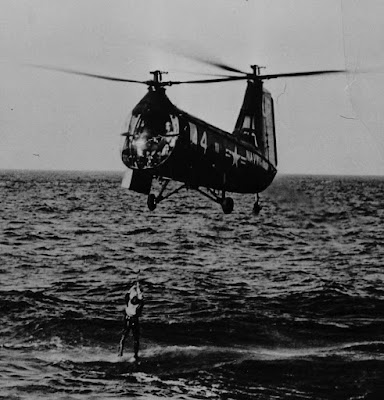The rescue hoist was mounted above the right front seat and the rescue hatch below it so it had to be removed or folded forward for hoist operations:
Note that the flight controls including the cyclic, as shown above, might remain in place but the seat could not be folded forward unless it was removed.
However, the pilot and crewman had to be insure that the rescuee didn't grab the controls as he came into the cabin.
There were several instrument panel arrangements. The top one was BuNo 128503-128600.
The cabin interior ended at the attachment point for the aft main landing gear strut;
The engine was mounted aft of the hole in the bottom of the fuselage and backwards, so the drive shaft pointed aft and the engine exhaust stack was forward of the engine.
The engine was mounted at an angle and drove a gearbox that had outputs forward to the front rotor and upwards to the aft rotor.
The engine was encased in a shroud. There was a fan on the "front" of the engine that sucked air in from the openings in the front of the pylon for engine cooling. The air exhausted out the opening in the bottom of the fuselage. An oil cooler was mounted at the rear of the opening.
The above inboard profile was created before the second pair of air inlets was added to the leading edge of the pylon and it appears to have an early version of the trailing edge of the fin. (The second pair of air inlets was added to leading edge of the HUP's aft pylon after it first entered service in order to increase cooling air to its hard working radial engine mounted in the fuselage.) The opening looks like a rounded rectangle from the side but because of the airfoil shape of the pylon cross section and the pylon's interface with the fuselage, it looks very different when viewed from other angles.
As a result, some kits have gotten the shape of the opening wrong.
This fuselage stations drawing can't be strictly relied on for shape but the station dimensions should be accurate (the overall length of the "shadow" on the ground was 31' 11"):
Or a bit less as shown on this three view;
Note the shape of the rotor blade on the three view above. There were three different rotor blades. The first type had a tapered rounded tip as shown on the three view. The second had a constant chord of 1' and the outboard section was slightly twisted leading edge down with no taper. The third may be the same the same as the second in overall shape but was all-metal rather than being a wood-covered steel tube.
As far as I know, the rotor diameter was 35' for all blades.
The HUP-3s were H-25s built under contract to the Army. Fifty were delivered to the Navy instead. The H-25s had a slightly different interior and a different rotor head; the Navy may have installed the HUP rotor heads at some point.
(My guess is that the difference was the need for droop stops to keep the rotor from flapping excessively during startups and shutdowns on an aircraft carrier making a relatively high wind over deck for airplane takeoffs and landings.)
Another difference was that some H-25s (51-16577 and 51-16584 and subsequent) had a fairing on the right side of the fuselage associated with the field litter installation ( seen here under the side number of HUP-3 BuNo 147602):
For an excellent in-box review of the Amodel 1/72 HUP kit, see http://alexsmodelling.blogspot.ru/2017/03/hup-retriever-amodel-kit-review.html
Gordon Hewstone built the Siga 1/72 UH-25B kit: "It's a relatively crude kit to which I added a few details such as the lights and wiring on the landing gear".

















A great forgotten aircraft. The Mach 2 kit looks good with a lot of TLC. Why did it have end plates added? Thank god There's a few left on exhibit.
ReplyDeleteInstructions aren't clear about top side and bottom side rotors colors til after you find that out when it's finished. Those folded blade supports would really make for a nice touch to a finished model of a active HUP of the 50's, not like the Pima sun & sand beaten supports do now.